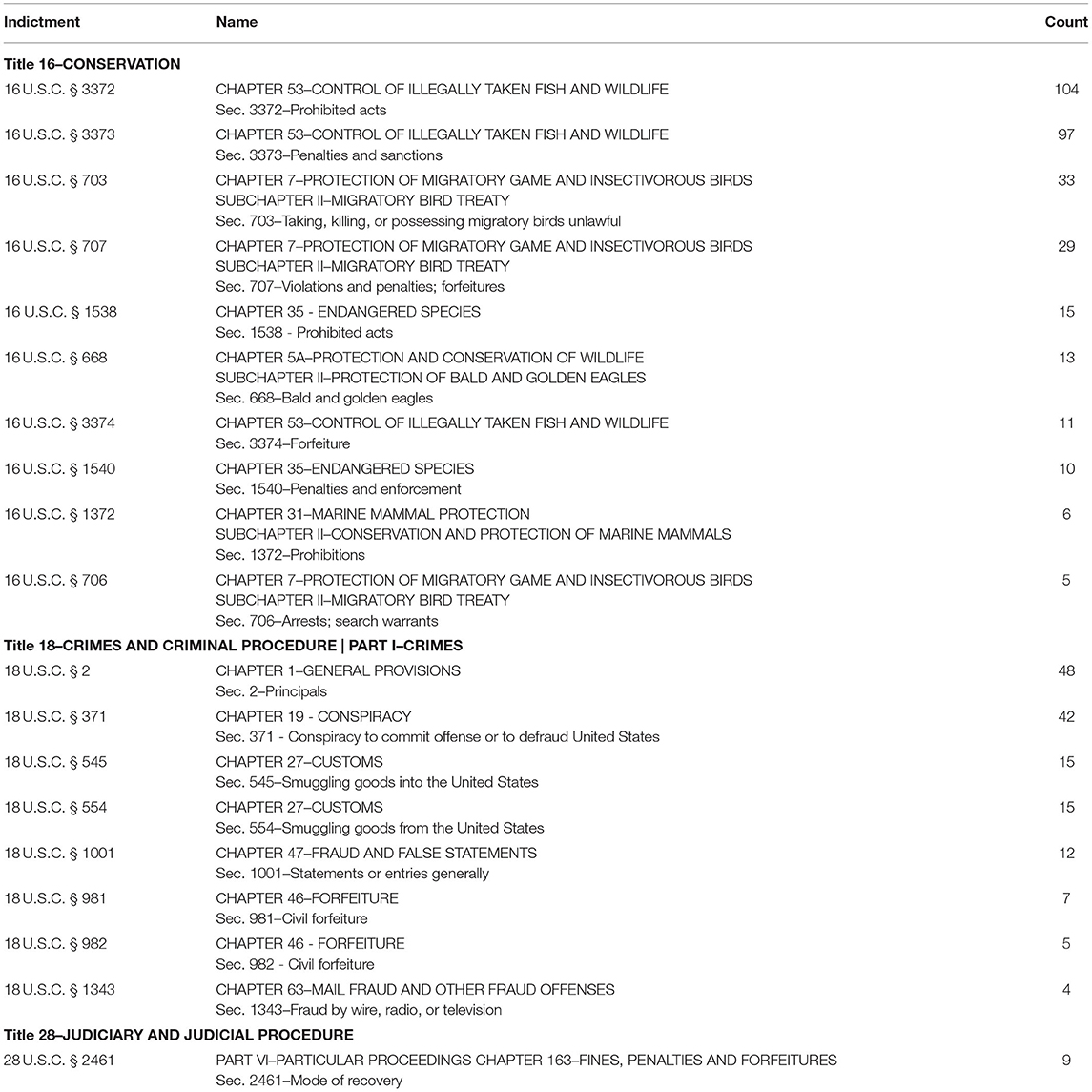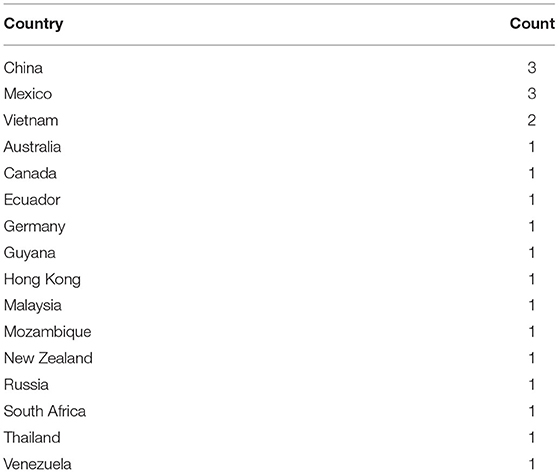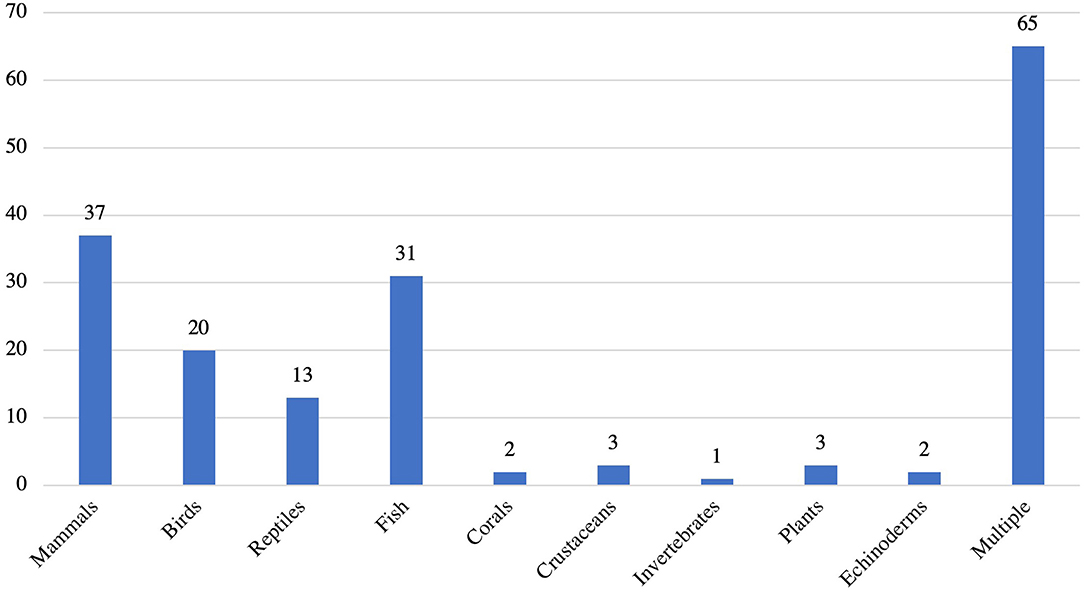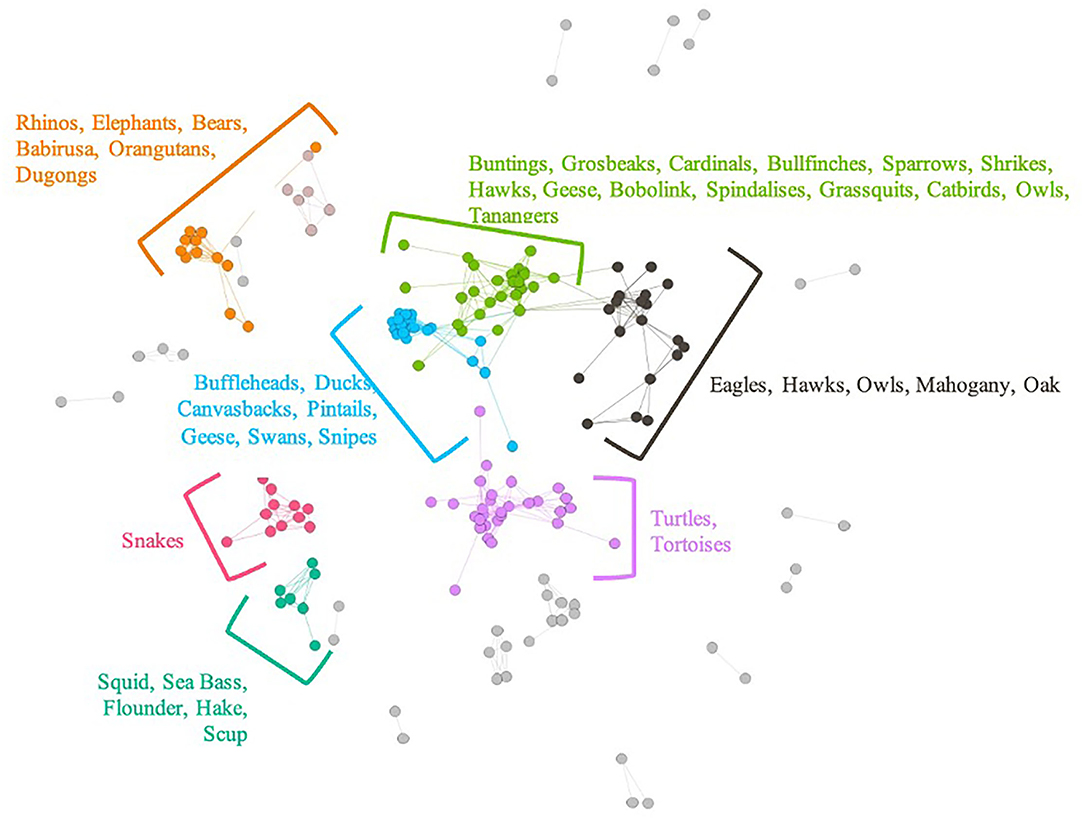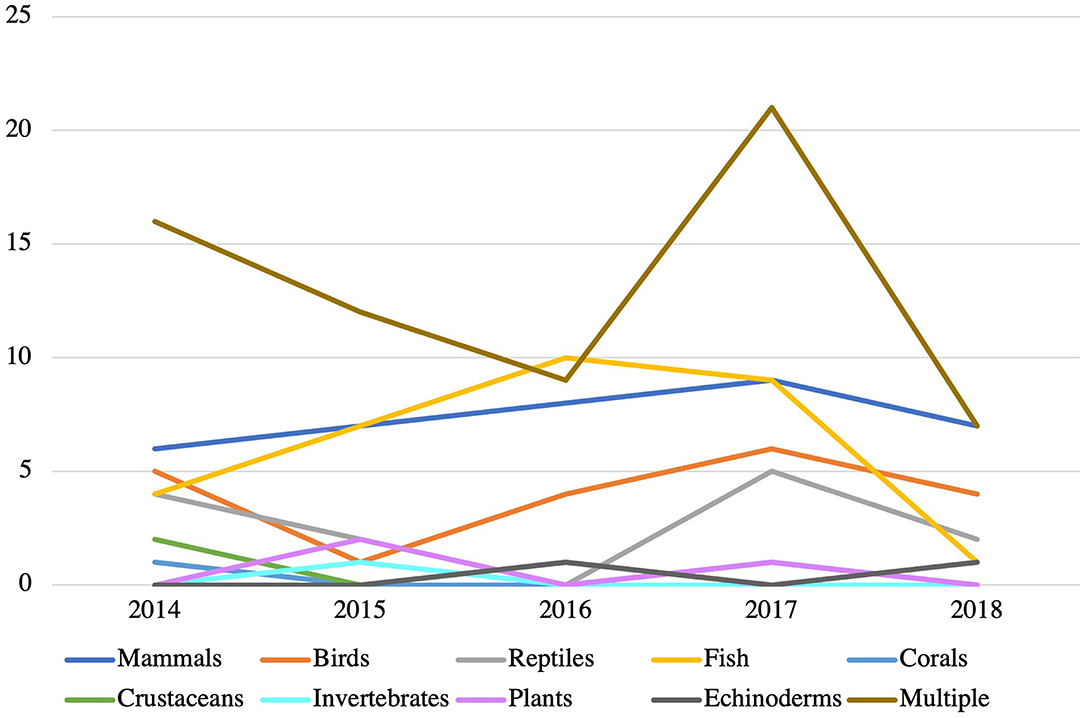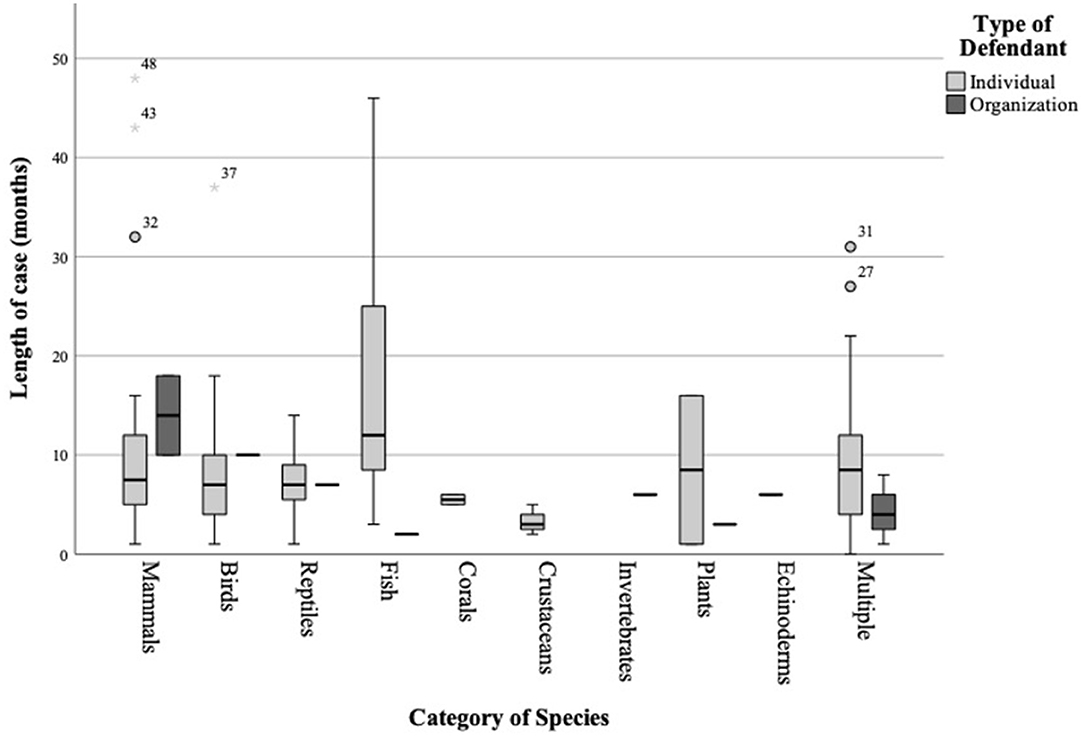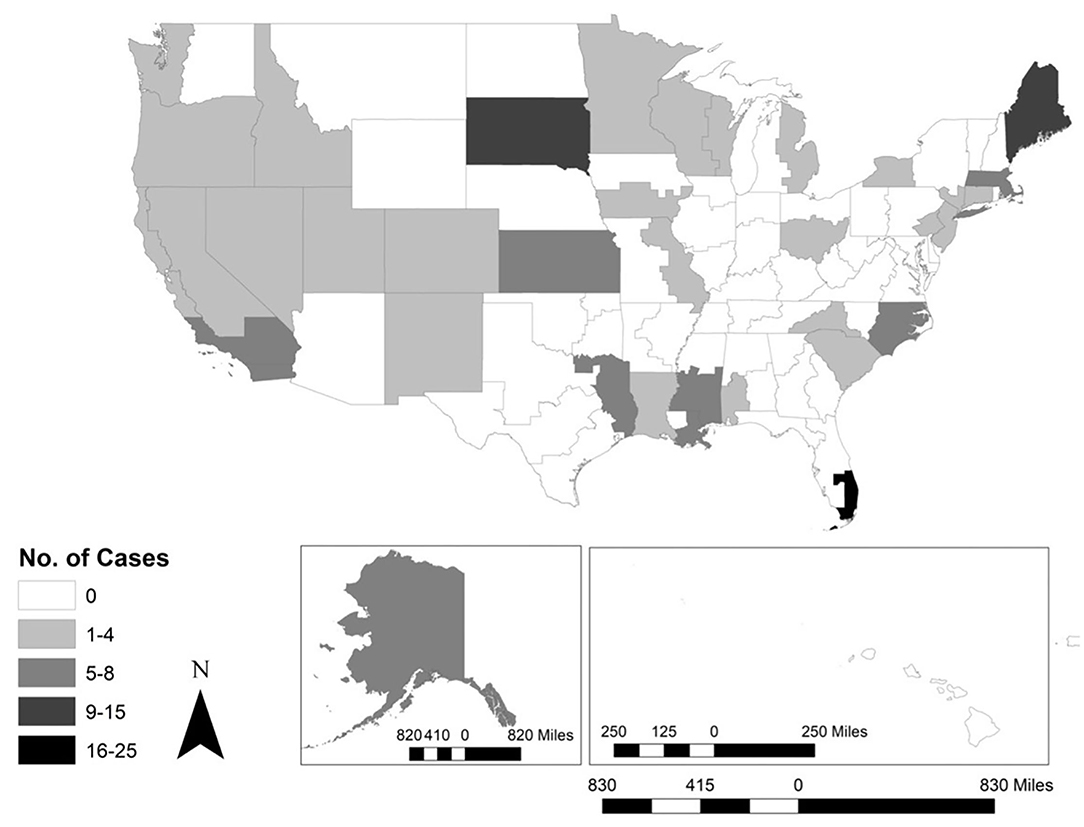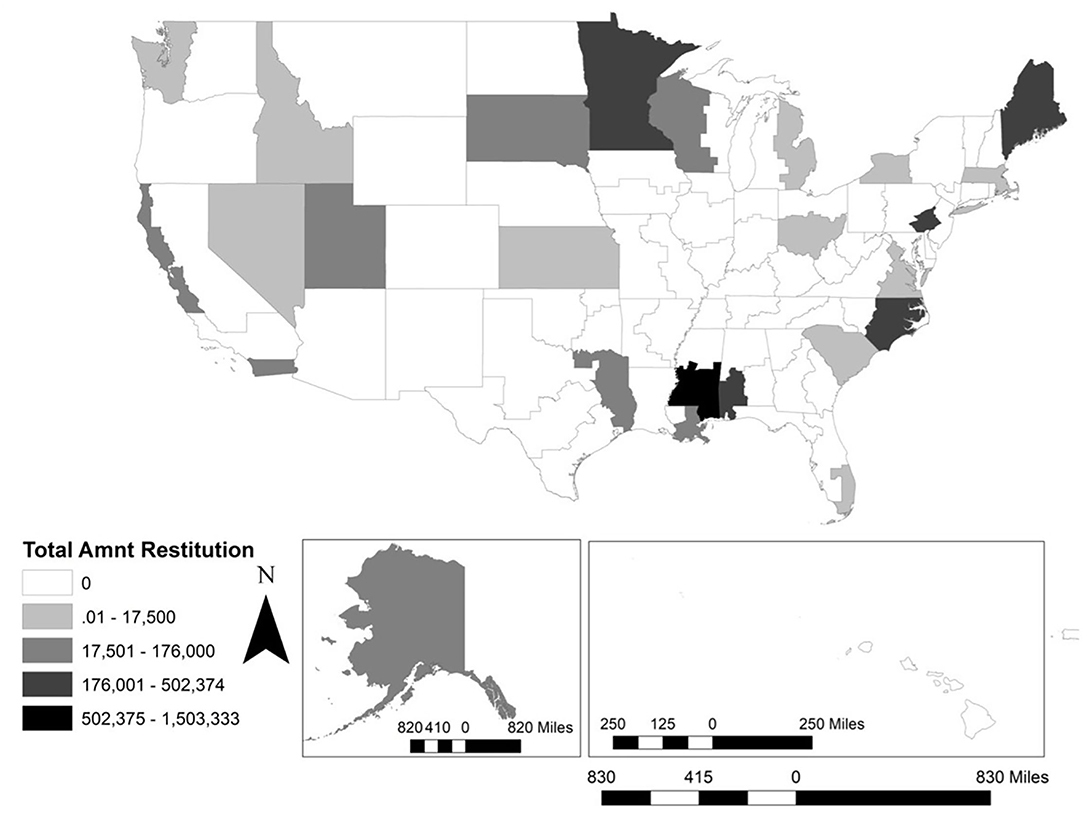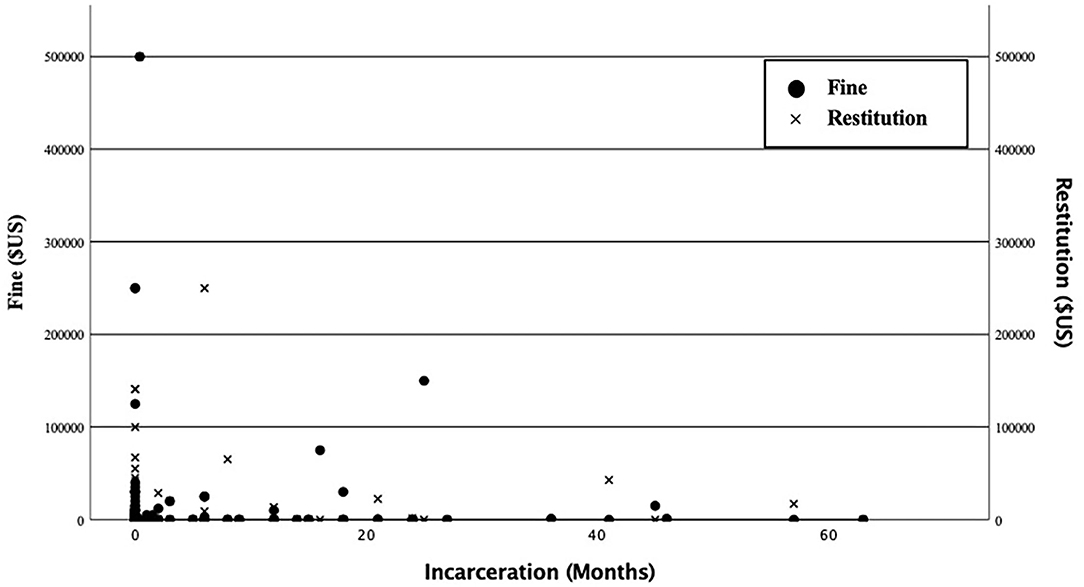- 1John Jay College of Criminal Justice, Department of Criminal Justice, New York, NY, United States
- 2Arnold and Porter, New York, NY, United States
Wildlife crime threatens national and global security. Much of the impact of wildlife crime is felt overseas, often in developing countries, where it threatens to catalyze conflicts, hinders economic development, undermines the rule of law, and threatens peace, amongst having other negative socio-economic and security impacts. But the impact of wildlife crime also is felt in United States, both directly by undercutting state and local conservation efforts, and indirectly, by injecting illegal wildlife and wildlife products into United States markets. While some work has delved into the sentencing dynamics of broader environmental crime in the United States, little research has explored the sentencing of wildlife crime, which is recognized as being distinct in nature by both governmental bodies and academics alike. The current study explores the federal prosecutions of wildlife crimes, focusing on profiling the wildlife crime cases charged by the US Department of Justice (DOJ). By profiling cases, we aim to explore (1) the application of charges associated with wildlife crime cases via their judgment documents; (2) the wildlife species involved in prosecuted cases; (3) the distribution of cases across US federal districts; and (4) and the sentencing patterns of wildlife crimes. Further statistical analyses explore the relationships between a variety of the variables extracted. Policy recommendations are set forth accordingly.
Introduction
Wildlife crime refers to crime relating to wild flora and fauna. More specifically, it is defined as the illicit taking, transport, trade, or possession of animals, animal parts, and derivatives thereof in contravention of foreign and domestic laws and treaties (Sosnowski and Moreto, 2021). While these activities are evidently linked to conservation concerns, wildlife crime has significant impacts beyond the environmental or ecological realm of conservation. Wildlife crime—from poaching through trafficking—threatens national security, catalyzes certain conflicts, hinders economic development, undermines the rule of law, and threatens peace, amongst having other negative socio-economic and security impacts (Wyler and Sheikh, 2013; Douglas and Alie, 2014; Nellemann et al., 2016).
Despite these broad-ranging impacts, wildlife crime is a relatively low risk, high reward activity. The low risk of engaging in wildlife crime begins with the relatively small chance of being detected at the time of poaching, and continues up the supply chain through the consumption of trafficked goods, and the eventual low risk associated with potential prosecution (O'Hear, 2004; Elliott, 2012; EIA, 2015; Lynch et al., 2016; Lynch, 2017, 2019; Cochran et al., 2018). The high reward comes from the high value (often monetary) that traffickers often receive when selling the illegal wildlife products. Certain products, such as ivory or rhino horn, for example, are worth more than their weight in gold (Hübschle, 2016; Sosnowski et al., 2019).
While some work has delved into the sentencing dynamics of broader environmental crime in the United States (i.e., Lynch et al., 2016; Lynch, 2017, 2019, 2021; Cochran et al., 2018), little research has explored the sentencing of wildlife crime, which is distinct in nature (i.e., Wyler and Sheikh, 2013; The White House, 2014). Crow et al. (2013) provide the only identified study into criminal enforcement surrounding fish and wildlife offenses. Their analysis, limited to Florida data from 2006, highlighted that only a small fraction of cases prosecuted were fish and wildlife offenses [only 2.2% (n = 15, 657) of all offenses in the state], and that these prosecutions primarily were focused on individual as opposed to organizational offenders. As for penalties, nearly half of these cases were charged with permit violations (i.e., for having no or improper hunting/fishing permits).
The United States is one of the largest consumer (and transit) countries for the global illegal wildlife trade (Petrossian et al., 2016; van Uhm et al., 2019; Hitchens and Blakeslee, 2020), which is estimated to be worth from $7 billion to $10 billion annually (excluding fish and timber) (Wyler and Sheikh, 2013). While studies have attempted to quantify the general patterns of trade into the US (Petrossian et al., 2016; Eskew et al., 2019; van Uhm et al., 2019), there have yet to be attempts to more broadly understand the consequences of such crimes as processed by the federal courts. The current research, therefore, aims to contribute to this conversation, specifically using federal court records to unveil more broadly how the United States Department of Justice handles wildlife crime.
Federal Prosecution of Wildlife Crime
In the United States, the Department of Justice's (DOJ) Environmental Crimes Section (ECS) of the Environmental and Natural Resource Division (ENRD) works with the United States Attorneys' Offices across the nation to prosecute wildlife crimes, which fall within ENRD's larger scope of prosecuting environmental crime. The wildlife crime cases within ECS' purview primarily involve enforcing the Endangered Species Act (ESA) and the Lacey Act, as well as related, more generally applicable crimes, such as smuggling, money laundering, and criminal conspiracy. Indicting, prosecuting, and convicting offenders for violating the protections of both internationally (i.e., ivory, rhino horn, narwhal tusk, shark fins) and domestically (i.e., mountain lions, bobcats, rattlesnakes, paddlefish) safeguarded species cases often are handled in collaboration with the Department of the Interior's Fish and Wildlife Service (FWS), the National Oceanic and Atmospheric Administration (NOAA), as well as other relevant agencies (Wildlife Trafficking, 2020).
The federal enforcement of wildlife protection laws dates to 1900, when Congress passed the Lacey Act. The commercial hunting of game species was threatening many species with extinction. Although states had regulations designed to protect wildlife from overhunting, those state laws were unable to contend with interstate commerce in wildlife, or the wildlife trade. In its present form, the Lacey Act, among other things, makes it a federal crime to trade in illegally hunted or captured wildlife across US and state borders (Prosecution of Federal Wildlife Crimes, 2015).
The Current Study
The current study delves into the federal1 handling of wildlife crimes, focusing on profiling the wildlife crime cases charged by the US DOJ. By profiling cases, we aim to determine (1) the charges associated with wildlife crime cases through their indictments or criminal informations (henceforth, indictments)2 (i.e., what wildlife laws are being broken as well as what non-wildlife laws are involved), (2) what wildlife species are involved in prosecuted cases, (3) where in the US wildlife cases are prosecuted (i.e., is there a geographic trends associated with how wildlife crime is treated?), (4) and the charging patterns of wildlife crimes.
Examining prosecutorial patterns in wildlife crime cases specifically responds to calls made by Executive Order 13648 (Combating Wildlife Trafficking) (The White House, 2014) to better understand how wildlife crime is handled by the US government. Among other things, the Executive Order's Implementation order calls for an examination of the “existing tools used to target the assets of wildlife traffickers and wildlife trafficking networks including administrative, civil, and criminal fines and penalties; community service payments; forfeiture; and restitution,” all in an effort to inform the “increase and further institutionalization” of these tools. Domestically, it also seeks to “analyze and assess legal authorities used to deter, investigate, and prosecute wildlife trafficking, as well as other types of trafficking, associated money laundering, and related crimes, to determine obstacles and gaps that impede successful investigation and prosecution and additional tools that can be used” (The White House, 2014). While this study will go beyond exclusively wildlife trafficking cases, as these represent only a small fraction of wildlife crime in the country, trafficking cases will fall within the cases analyzed.
Methods
Identifying Cases
This study used the Department of Justice's Environmental and Natural Resource Division's (ENRD) monthly bulletin3 to identify prosecuted wildlife crime cases. At the time this study was undertaken, the “Environmental Crimes Monthly Bulletin” was available monthly from 2011 through 2018. The bulletin summarizes recent developments in criminal environmental matters, as it aims to “help to keep federal, state, and local environmental prosecutors and investigators informed about relevant pollution and wildlife cases and increases information sharing between the U.S. Department of Justice, U.S. Attorneys' Offices, and other federal, state and local law enforcement.” The bulletins are released publicly pursuant to the Freedom of Information Act or are proactively disclosed by ENRD (Department of Justice, 2018).
Wildlife cases were identified by the researchers within these bulletins based on the stated violation of an array of federal wildlife laws4 (i.e., The Lacey Act, The Endangered Species Act, The Marine Mammals Protection Act, etc.). This selection process aimed to weed out other offenses litigated by the ENRD, such as pollution crimes, animal welfare crimes, and worker safety crimes. This selection reflects the interest for the current study and a narrowed definition of “wildlife crime.” Because the bulletins themselves typically lacked certain nuanced information—such as the criminal offense citation (ex. 18:371 Conspiracy to Defraud the United States—Lacey Act DOF) or the species involved—we used the case numbers listed in the bulletins to obtain the relevant court documents through the PACER (Public Access to Court Electronic Records) database5.
Data Collection
PACER provides electronic public access to federal court records. It allows users to obtain case and docket information from the United States district courts, United States courts of appeals, and United States bankruptcy courts. The system is managed by the Administrative Office of the United States Courts in accordance with the policies of the Judicial Conference, headed by the Chief Justice of the United States.
Each court maintains its own system, with a small subset of information from each case transferred each night to the U.S. Party/Case Index server, located in San Antonio, Texas at the PACER Service Center. Records are submitted to the individual courts using the Federal Judiciary's Case Management/Electronic Case Files (CM/ECF) system, and usually accepts the filing of documents in the Portable Document Format (PDF) through the courts' electronic court filing (e-filing) system. Each court maintains its own databases with case information. Because PACER database systems are maintained within each court, each jurisdiction will have a different URL.
The PACER System offers electronic access to case dockets to retrieve information such as
• A listing of all parties and participants including judges, attorneys, and trustees
• A compilation of case related information such as cause of action, case number, nature of suit, and dollar demand
• A chronology of dates of case events entered in the case record
• A claims registry
• A listing of new cases each day
• Appellate court opinions
• Judgments or case status
• Types of documents filed for certain cases
• Many courts offer imaged copies of documents
Data Extraction
We obtained the relevant case numbers from 2014 through 2018 from the ENRD bulletins and then searched PACER for the corresponding court docket sheets and the relevant underlying filings. This resulted in 176 available cases. The 5-year time frame was selected due to both time and budgetary restrictions relating to the extraction of PACER case data. We extracted two files per wildlife case in our data set: (1) the operative information/indictment and (2) the judgment. We selected these two file types because they typically contain the information we needed for this study.
Our team thoroughly studied each information/indictment and judgment file to extract information on the name of the defendant, the district in which the crime was charged, the court involved, the date of conviction, and the wildlife species involved. We also extracted the cited violation(s), the Sentencing Guidelines offense, the species involved, the judgment and sentencing (i.e., fines, jail/prison time, community service, forfeiture, probation), and the investigating agencies.
Coding
The team coded all extracted data to develop a comprehensive dataset. We recorded indictments and informations as appearing in the indictment/information files. US federal court districts were recorded as appearing in the case documentation. The type of defendants charged were divided into three categories—individual, company, and both. Cases that had companies listed as the defendant (i.e., Wildlife Management, LLC.) were classified as “organizations”; a case with both a company name and an individual were listed as “both”; and individuals were coded as “individuals.” We coded the number of individuals who worked together from one to four or more. The wildlife involved in the crime was coded by species as well as divided them into ten categories on the basis of taxonomic “class”; these categories included: mammals, (migratory) birds, reptiles, fish, corals, crustaceans, invertebrates, plants, echinoderms, and multiple species. Foreign (i.e., non-US states or territories) countries mentioned in the information casefile were collected and coded as numbers alphabetically. Weapon-involvement was coded “yes” or “no.” The fine (moneys paid to the federal or local government prosecuting the crime), monetary forfeiture6 (government seizure of property and/or funds associated with criminal activity), and restitution (moneys paid to the victim or restitution fund) were each coded separately as the exact dollar US ($) amount. Community service hours were taken from the judgment file, along with the incarceration, probation, and supervised release, each coded as exact months of the sentence.
Analytic Strategy
After gathering the data, we performed geographic, temporal, and statistical analyses of the federal wildlife crime cases using Esri ArcGIS and SPSS, respectively. Because the data was not normally distributed (as indicated by skewness and kurtosis measures), non-parametric tests were used for all statistical tests.
We also applied network analysis to examine cases where multiple species were involved. Network analysis is a technique that aids in the understanding of relationships between various actors or entities. It uses nodes to represent individuals, actors, or other entities (such as species) with relationships to one another, alongside edges, which are the lines drawn connecting the nodes together. For the purpose of the current paper, network analysis is applied to visualize the relationships between species involved in any given case involving multiple species. This makes the nodes of interest the indictments and the species. This analysis was performed using Gephi (software).
Results
We examined indictment and judgment documents for 176 identified and available wildlife cases associated with 180 charged offenders; the larger number of charges due to cases with multiple charged offenders. Of these offenders, 163 were individuals, while 11 were organizations, and six (6) charges were associated with both. Because the courts treat individuals and organizations differently for sentencing purposes (Lynch, 2017), we separated the cases based on defendant type; the six (6) cases involving both defendant types (i.e., included both an individual and organization listed as defendants for a case) were removed from the dataset. Descriptive statistics are available in Tables 1, 2, disaggregated by defendant type (Table 1 displayed individuals, Table 2 displays organizational).
For individuals, fines ranged from $0–500,000 per case, totaling over $2.3 million over the 5 years examined with a median fine of $750. Restitution fell within the same range, from $0–500,000 per case, totaling just under $2.0 million; the median, however, was $0. Financial forfeiture ranged from $0–1,000,000, totaling just over $1 million, again with a $0 median. With respect to non-financial penalties, such as incarceration, community service, and supervised release: sentences of incarceration ranged 0–63 months, or up to about 5.25 years, with an average sentence was roughly 5 and a half months (SD = 11.72) with a median of zero (0) months; community service ranged from 0 to 500 h, with an average of ~36 h (SD = 89.53) and a median of zero (0) hours; supervised release ranged 0–72 months, with an average of about 10 months (SD = 16.52) and a median of zero (0) months. As for case-specific details, the time from indictment to judgment ranged up to 48 months (mean =10.35, SD = 9.15, median = 8.00). There were from one (1) to 17 different wildlife species involved per case (mean = 2.04, SD = 2.39, median = 1.00). Just over 62% of cases has one individual defendant involved, while nearly 21% had two individuals, and 7.4% had three, with the final 9.2% having four or more. All variables examined were skewed right (statistic > +1.0) and leptokurtic (value > +1.0). The percentage of cases with zero (0) values is found in the column farthest to the right.
For the 11 organization-associated cases, fines ranged from $0–7,800,000, with a mean of $1.1 million (SD = 2.37 million) and a median of $500,000. Restitution ranged $0–367,000 with a mean of $0. Forfeiture ranged $0–297,500, again with a mean of $0. Regarding non-financial penalties, community service ranged 0–200 h (mean = 18.18, SD = 60.30, median = 0.00). Incarceration ranged 0–21 months (mean = 1.91, SD = 6.33) with a median of zero (0) months, while supervised release ranged 0–36 months (mean = 3.27, SD = 10.85) again with a mean of zero (0) months. The length of the case ranged up to 18 months (mean = 6.9, SD = 5.01, median = 7). The number of species involved per case ranged 1–4 (mean = 1.45, SD = 0.93, median = 1). In eight (8) of these cases, only one individual was involved; one case was associated with two, three, and four or more individuals, each. All variables examined were skewed right (statistic > +1.0). All are leptokurtic (value > +1.0). Percent of cases with zero (0) values is found in the column farthest to the right.
Restitution from both individual and organization-associated cases was provided to 33 organizations or government entities (see Supplementary Table 1). US Fish and Wildlife Service had the greatest number of associated cases (N = 8).
Indictments
Sixty-four statutes were applied across the cases analyzed. Cases in which violations of specific statutes were charged more than three times can be found in Table 3 (see Supplementary Figure 1 for full list of statutes and application counts). These included those falling under Titles: 16—Conservation, Title 18—Crimes and Criminal Procedure (notably, Part 1), and Title 28—Judiciary and Judicial Procedure. Within Table 3, Title 16 offenses were charged most often (N = 9) and with the greatest frequency (N = 308). Of these 16 U.S.C. § 3372 was applied the greatest number of times (N = 104), followed by 16 U.S.C. § 3373 (N = 97), and 18 U.S.C. § 2 (N = 48).
International Wildlife Trafficking
In 30 cases, wildlife contraband was imported from another country. In 17 of these cases, the indictment and judgment files did not specify the particular source country. All specified countries can be found in Table 4. Cases involving multiple countries were disaggregated (i.e., if both China and Vietnam were involved in the same case, each country was counted individually). Fifteen countries were specified across these 30 cases. China and Mexico were most commonly involved (N = 3), followed by Vietnam (N = 2). All other countries involved were only named in one case each.
Mann-Whitney U tests for non-parametric data were used to compare the cases involving foreign nations to those not involving foreign nations. Due to sample size, only individual-associated cases were examined. No significant differences were found for the length of the case (p = 0.291, U = 1525.500), amount of fine (p = 0.872, U = 1709.000), amount of restitution (p = 0.828, U = 1691.000), or imprisonment (p = 0.610, U = 1570.500) for cases involving foreign nations vs. those that did not involve foreign nations.
Species Involved
Across the case files, there were 204 unique species listed, with a total of 362 incidents, as many species appeared more than once across the studied cases. Of listed species, 175 either had a scientific name listed in the case records, or the species name was easily identified based on the listed common name. Unfortunately, 27 species were listed generally (i.e., “deer” or “lobster”). This could contribute to potential overcounting in terms of the number of unique species involved and undercounting in terms of the incidents per species. Given that there were 176 total cases included in the dataset, 204 individual species represent a ratio of 204:176, or ~1.16 unique species per case, and about 2 individuals per case (362:176). Supplementary Table 2 contains a full list of species.
The most commonly involved species was the Bald eagle (Haliaeetus leucocephalus) with 17 incidents. Next was the American eel (Anguilla rostrata) with 14 incidents. The Black rhino (Diceros bicornis) and unspecified “Rhinoceros” both had eight cases each. The Golden eagle (Aquila chrysaetos) and Red-tailed hawk (Buteo jamaicensis) came in with seven each. Asian elephant (Elephas maximus), Blue grosbeak (Guiraca cycaerulea), African elephant (Loxodonta africana), Atlantic striped bass (Morone saxatilis), White tailed deer (Odocoileus virginianus), Ingido buntings (Passerina cyanea), and general “(migratory) bird” each had six (6) incidents. All other species had 5 or fewer incidents. Figure 1 depicts the total case counts per species category.
Multiple Species Cases
Cases that involved multiple species were analyzed using network analysis (Figure 2). Select groupings arose on the basis of this analysis; meaning that certain species tended to appear alongside other specific species in the cases. These are color-coded accordingly in Figure 2, which illustrates these species combinations. The purple group, which made up 16.57% of the network, was comprised entirely of turtle (and one tortoise) species. The green and blue groups, which made up 15.43% and 12% of the network, respectively, were comprised entirely of bird species (species details in the visualization). The brown group, made up 10.86% of the network, and was made up of mainly eagles, hawks, owls, mahogany and oak. The orange group, comprising 7.43% of the network, was comprised of many larger species, such as elephants, rhinos, bears, orangutans, dugongs, and babirusas. The pink group, making up 6.29%, was entirely snake species, and the turquoise group (4%) was all squid and fish. From this graph, it becomes clear species were most likely to be trafficked with other species from a similar group, i.e., birds were most likely to be trafficked with other birds, snakes with snakes, turtles with turtles, and so on. We observed little crossover between groups.
Temporal Aspects
Number of Cases by Species Group Over Time
Across all ten wildlife categories [i.e., mammals, (migratory) birds, reptiles, fish, corals, crustaceans, invertebrates, plants, echinoderms, and multiple species], the greatest number of cases in any given year were multiple species in 2017 (N = 18), followed by mammals and fish (both N = 9). Cases generally increased in 2017, notably for multiple species cases from just nine (9) the year prior. In 2018, cases seemed to drop back down to pre-2017 levels, with decreases observed in nearly all species categories (Figure 3).
Case Duration
Figure 4 displays the case duration statistics for individual and organizational cases, disaggregated by species grouping. To avoid duplication created by including cases with multiple species grouping, we included only cases involving a single species category. For single species categories associated with individual cases, the mean case length was 11.36 months (N = 98, SD = 10.47). The maximum case length was 48 months, or roughly 4 years. Across species categories, fish saw the highest median and maximum case lengths, although several outliers arose across mammals (migratory) birds, and fish (denoted with circles and stars annotated with the month length). Organizational case lengths for single-species cases were generally shorter than those of the individual cases. However, this may be an artifact of the notably smaller sample size (N = 7 vs. 98 for organizational and individual single-species cases, respectively). Organizational cases had an average eight (8) month duration (SD = 5.39) and a maximum length of 18 months. However, as Figure 4 illustrates, the median duration for mammal and bird cases were higher for organizational than individual single-species cases.
Spatial Aspects
Considering all cases (i.e., individual and organizational), certain federal districts saw higher total case numbers over the 5-year period examined. For example, the Southern District of Florida had 25 cases, the most of any US Federal District. South Dakota followed, with a total of 14 cases; Maine was third with 12 cases. All other US Federal Districts had <10 cases each, with a number having no wildlife cases at all over the 5-year period (Figure 5). Restitution was also examined across federal districts and showed patterns that differed slightly. SD Mississippi saw the most restitution ordered over the 5-year period, with a total of $1,502,333. This was followed by Minnesota with $502,374 and SD Alabama with $367,000. Only 24 districts had any restitution at all (Figure 6). Supplementary Table 3 details the total number of cases, the total number of cases with restitution, and the total amount of restitution (USD$) per federal district.
Sentencing
Species Categories and Sentencing
We focused on three related questions regarding sentencing: Does the (1) amount of fine, (2) amount of restitution, or (3) length of incarceration relate to the species categories? Because nearly all variables showed significant skewness, we used Kruskal-Wallis H non-parametric tests for the analyses. Because this test is somewhat simplistic, and control variables cannot be included, we analyzed only individual-associated cases and cases where a single species category was involved (i.e., multiple species cases were excluded).
In examining the relationship between the amount of financial penalty/compensation (fine and restitution, respectively) and the species category, we found that there were no significant differences in terms of the fine (p = 0.237, h = 9.217, df = 7, N = 98), but that there were significant differences for length of incarceration (p = 0.021, h = 16.531, df = 7, N = 97), and near significant differences in terms of restitution (p = 0.054, h = 13.872, df = 7, N = 97). Therefore, the data we gathered suggests that species category does appear to have some relationship to the sentencing outcomes of restitution and the length of incarceration.
US Federal District and Sentencing
Further to determine whether certain districts handled these cases differently than others, district and sentencing outcomes were analyzed using Kruskal-Wallis H tests. Results indicated that there were no significant differences in the length of incarceration assigned for individual-associated cases by the various federal districts (p = 0.507, h = 35.180, df = 36, N = 145) or fine (p = 0.110, h = 46.659, df = 36, N = 145), and a significant difference in restitution (p = <0.001, h = 69.585, df = 36, N =144) (Figure 7). Therefore, districts can be argued to have somewhat of an impact on sentencing outcomes, but that is likely to only be financial.
Financial Penalties, Compensation, and Incarceration
Lastly, there appears to be a generally inverse relationship between incarceration length and both fine and restitution for individual-associated cases (Figure 7). Cases receiving higher fines and/or restitutions are generally receiving lower jail/prison sentences. Using a Spearman's Rho correlation for non-parametric data, the jail/prison sentence and fine have a significant but weak negative correlation (p = 0.013, rs = −0.208, N = 142), restitution was not significant (p = 0.385, rs = −0.074, N = 141).
Intersections: Weapons
Out of the cases examined, 18 (or roughly 10%) involved weapons. Of the 18 weapons-involved cases, four (4) were associated with mammals, three (3) were associated with (migratory) birds, and 11 were associated with multiple species. In seven cases, weapons were listed as possible items for forfeiture (i.e., it was not specifically outlined whether the defendant had used a weapon or was still in possession of the weapon). In the remaining cases, weapons were used to kill wildlife in violation of wildlife regulations (N = 9) and in a single case, the defendant was charges with unlawful possession of a firearm by a felon, and in another the defendant was charged with possession of an unregistered firearm.
Discussion
In an attempt to better understand the patterns of wildlife crime cases handled by the federal courts in the United States, this research employed various analytical methods to answer four distinct research questions. These questions related to the nature of the charges involved when prosecuting these types of cases, the overall distribution of the cases across U.S. federal districts; the sentencing patterns; and the species involved. A total of 176 indictment and judgment documents were analyzed in detail to extract relevant information. The overall purpose of this research was to gain a better understanding of the nature, patterns, and trends of the wildlife crime cases handled federally in U.S. courts.
The analyses began with the examination of the various types of penalties applied to wildlife crime cases involving individual offenders. These included fines, which ranged from $0 to $500,000; restitution (which had a similar amount range); financial forfeiture (ranging from $0 to $1 million); as well as non-financial penalties that included incarceration (with the sentence ranging from 0 to 63 months); community service (with between 0 and 500 h); and supervised release (ranging from 0 to 72 months). While the ranges for the above-listed penalties were large, the higher numbers represented more the exception than the norm: the median fine did not exceed $750; the medians for restitution and forfeiture were $0; the median incarceration was zero months (while the mean was at the lower-end of the scale at 5 and a half months), as was the median supervised release (with the mean of 10 months) and the median community service hours (with the mean of 36 h). The sentencing outcomes for organization-associated cases were similar to the cases involving individual offenders, except for some differences in the fine ranges and median fine amounts: the medians for restitution, forfeiture, community service hours, incarceration length in months, and supervised release in months were all “0.” While the fines ranged from $0 to $7.8 million, the median amount of fine involving organization-associated cases did not exceed half a million dollars. It took the courts, in average about 11 months to process cases involving individuals, and about eight (8) months to process cases that involved organizations.
Wildlife crimes have serious implications, including human costs (Moreto and Pires, 2018); environmental costs (Petrossian, 2019; Rush et al., 2021); and health and safety risks (Wilson-Wilde, 2010; Haines et al., 2021). Some literature has also suggested the potential involvement of serious criminals and organized crime groups in the international trafficking of wildlife (Zimmerman, 2003; van Uhm and Wong, 2021), although others have pointed to different typologies of offenders involved. For example, in the case of market sellers of protected wildlife in Peru, Leberatto (2017) classified offenders into casual, transient, opportunistic, hidden, and professional. Regardless of the type of offenders involved, the impacts of wildlife crime are, nevertheless, significant, and the crime itself should be treated as one of a serious nature. However, our research found that the penalties for such crimes in the United States were relatively low. The United States is considered one of the largest importers of illegal wildlife, so the fact of low penalties for wildlife crime is alarming. These punishment outcomes could be possibly explained as follows. First, the federal courts may consider wildlife crime to be less serious than other types of economic or environmental crime (Lowther et al., 2002). Despite the more recent improvements of legislative and policy instruments that allow for relatively heavy fines or the use of prison sentences in the U.S., courts rarely use them in wildlife cases, making it harder to communicate the deterrent effect of punishment for committing such crimes (Nurse, 2015). Considering the scope and associated severity of all other cases they are dealing with on a regular basis, wildlife crime may be treated similar to a low-priority crime. Others have suggested that many judges have a poor grasp of the long-term environmental consequences of wildlife crimes, which explains their “meager penalties” if a guilty verdict is reached (Bricknell, 2010).
Second, the relatively light treatment by the federal courts in the U.S. may reflect society's views on wildlife crime and how these should be handled. There is even more pronounced lack of interest in wildlife crimes in the cases involving wild plant trafficking and exploitation, which is referred to as “plant blindness” (Margulies et al., 2019). There is also significant lack of enforcement and other resources targeted specifically at plant trafficking (Lavorgna et al., 2018). Even in most serious wildlife crime cases, society may perceive it as a less serious crime either because the public is less knowledgeable about its circumstances or have been led to believe that, regardless of the wildlife involved, wildlife crime does not involve direct harms to the human and, therefore, is less of a problem (Korsell, 2001). Third, federal courts' reluctance to sentence wildlife criminals to any length of jail or prison time may be merely due to the overcrowding of the U.S. prisons and the courts' concerns of adding more pressure onto an already overstretched corrections system. The latter, however, does not explain why penalties aside from incarceration for these types of crimes still remain notably low. We suggest that greater efforts be made by governments, environmental NGOs, and social media platforms to highlight the serious impact of wildlife crime eventually could prompt the courts to take these crimes more seriously, leading to more serious penalties that more appropriately reflect the severity of wildlife crime offenses.
Another set of analyses examined the type of species involved in the 176 cases examined. There were a total of 204 unique species identified, which included mammals, birds, and fish. The top three species involved included the American Bald Eagle (Halieaeetus leucocephalus) (n = 17 incidents); American eel (Anguilla rostrata) (n = 14); and the Black rhino (Diceros bicornis) plus an unspecified species of rhino (combined 8 cases). In all other cases, the species were involved in seven cases or below. When a modularity network analysis was performed to identify the “communities” or grouping of species with the cases that involved multiple species, the results showed that these groupings were mainly with similar genera: birds were trafficked with other birds, reptiles with reptiles, fish with fish, and so on. Overall, when all the cases were taken together, birds were the dominant genus. One possible explanation of American Bald Eagle's dominance in the prosecuted cases could be the symbolic value as the U.S.'s national emblem (Marusek, 2014), as well as the fact that the species is endemic to the continent. This could have prompted a sense of responsibility and duty for the courts to prosecute the cases involving this species. Additionally, the Bald eagle is not only protected under the Migratory Bird Treaty Act, but also under the Bald and Golden Eagle Protection Act (BGEPA) designed for the added protection of the species (Katzner et al., 2012). One approach to the aiding of the growth of the environmental conscience could potentially be the emphasis of the values and the shifting of our attitudes toward animals, because “understanding and managing wildlife is also about understanding and managing societies” (Herrmann et al., 2013, pg. 12). Developing positive attitudes and values toward animals will help enhance the human-animal relationships that will be more geared toward co-existence (Kachen and Krishen, 2020; Leavitt et al., 2021). These positive values toward animals will, subsequently, lead to behavioral changes (Fulton et al., 1996) not only among the general public (not to kill the animals in the first place), but possibly also in the courts (to prosecute using stronger deterrence tools).
Literature in the past has identified an intersection of wildlife crimes with other forms of serious crimes, such as drug trafficking (South and Wyatt, 2011; van Uhm et al., 2021); trafficking in guns (Vira and Ewing, 2014; Austin, 2019), and human smuggling and trafficking (OECD, 2018; Chapsos and Hamilton, 2019). When examining the intersection of wildlife crimes cases prosecuted in federal courts and other crimes, we found little evidence except that in roughly 10% of the cases weapons were used. However, these weapons were not trafficked alongside wildlife, but rather used as tools to facilitate the wildlife crime (e.g., in 10 cases involving birds, weapons were also identified). We did not identify any drug-related cases within the 176 examined. This likely indicates that, if there were wildlife crime cases involving drugs, the latter were made the primary charge and were, therefore, not listed within the Environmental and Natural Resource Division bulletins that prioritize wildlife crimes.
One notable limitation of extracting federal cases of wildlife crime from the ENRD bulletins is that it is unclear as to what percent of total federal wildlife crime cases can be found in these publications. The ENRD website states that the bulletins are disclosed pursuant to Freedom of Information Act request (FOIA) or proactively, however, whether this includes all cases or select disclosures is unstated. We remain confident, however, that analyzing the cases disclosed should be representative of all ENRD cases.
Conclusion
The trade and use of wildlife by humans as food, medicine, clothing, shelter, ritualistic purposes, and in warfare (Van Uhm, 2016) is not a new phenomenon, dating back to prehistoric times and comprising an integral part of human existence (Van Uhm, 2016). However, the commercialization of the trade that led to the over-exploitation and excessive use of wildlife is a phenomenon of the past several decades (Wyatt, 2013), leading to devastating impacts on the animals and the environment. Despite the increased awareness of these crimes and their subsequent impacts on the wellbeing of humans, security of nations, and the health of the environment, the U.S. federal justice system does not seem to have caught up with the “trend,” leading to a meager number of cases involving wildlife crime in the past several years. Considering there are tens of thousands of seizures made at U.S. ports of entry by the U.S. Fish and Wildlife, as evidenced from the LEMIS database (Petrossian et al., 2016), it appears that the vast majority of wildlife violations are not being handled criminally. Logical questions to ask are: how then are all the LEMIS seizures imported from outside of the U.S. being adjudicated and what are the outcomes of the seizures if they are not prosecuted at U.S. courts? Future research could potentially expand the database of federally handled cases and conduct a longitudinal analysis to understand whether, over time, the courts' approaches to handling wildlife crime cases have changed and if so, what could have potentially triggered that change. While this remains to be seen, we recommend that current approaches to wildlife crime prosecutions in the United States, a leading global player, be shifted to signal the rest of the world that it is not willing to tolerate such crimes and is willing to prosecute the offenders to the fullest extent of the law. Such messaging can have lasting impacts and broad repercussions, given the United States is one of the major importers of illegal wildlife in the world (World Bank, 2008; Wyler and Sheikh, 2008; Fears, 2014).
Data Availability Statement
The raw data supporting the conclusions of this article will be made available by the authors, without undue reservation.
Author Contributions
MS contributed to the conceptualization of the paper, drafting of the introduction and methods sections, conducted the statistical analyses of the data, and drafted the results section. YK contributed to the collection and coding of the data, as well as the drafting of the Introduction and Methods sections. GP contributed to the conceptualization of the paper, analyses of the data, and drafted the discussion and conclusion sections. MA contributed to the conceptualization and the editing of the paper. All authors contributed to the editing of the final drafts of the paper.
Funding
This research has been funded by the John Jay College of Criminal Justice Office of Advancement of Research (for open-access publication fees).
Conflict of Interest
MA was employed by company Arnold and Porter.
The remaining authors declare that the research was conducted in the absence of any commercial or financial relationships that could be construed as a potential conflict of interest.
Publisher's Note
All claims expressed in this article are solely those of the authors and do not necessarily represent those of their affiliated organizations, or those of the publisher, the editors and the reviewers. Any product that may be evaluated in this article, or claim that may be made by its manufacturer, is not guaranteed or endorsed by the publisher.
Supplementary Material
The Supplementary Material for this article can be found online at: https://www.frontiersin.org/articles/10.3389/fcosc.2021.811516/full#supplementary-material
Footnotes
1. ^A number of wildlife cases are handled by state authorities, but the circumstances under which cases may be handled by the federal vs. state authorities is a complex issue beyond the scope of the current study. This study focuses on federal cases.
2. ^We did not examine criminal complaints because these initial charging documents typically do not reflect the ultimate resolution of a particular case, which typically is resolved through an indictment or an information.
3. ^https://www.justice.gov/enrd/selected-publications/environmental-crimes-monthly-bulletins.
4. ^Wildlife Crimes: Fish and Wildlife Coordination Act, 16 U.S.C. §§ 661–667e; Bald and Golden Eagle Protection Act, 16 U.S.C. §§ 668–668; National Wildlife Refuge System Administration Act, 16 U.S.C. §§ 668dd−668ee; Sikes Act, 16 U.S.C. §§ 670a−670o; Migratory Bird Treaty Act, 16 U.S.C. §§ 703–712; Migratory Bird Conservation Act, 16 U.S.C. §§ 715–715r; Airborne Hunting Act, 16 U.S.C. §§ 742j-1; Northern Pacific Halibut Act of 1982, 16 U.S.C. §§ 773–773k; Whaling Convention Act, 16 U.S.C. §§ 916–916ii; Fur Seal Act of 1966, 16 U.S.C. §§ 1151–1175ii; Marine Mammal Protection Act, 16 U.S.C. §§ 1361–1423h; Endangered Species Act of 1973, 16 U.S.C. §§ 1531–1544; Magnuson-Stevens Fishery Conservation and Management Act, 16 U.S.C. §§ 1801–1891d; Antarctic Conservation Act, 16 U.S.C. §§ 2401–2413; Antarctic Marine Living Resources Convention, 16 U.S.C. §§ 2431–2444; Lacey Act Amendments of 1981 (Lacey Act), 16 U.S.C. §§ 3371–3378, 18 U.S.C. § 42; Atlantic Salmon Convention Act, 16 U.S.C. §§ 3601–3608; Pacific Salmon Fishing Act, 16 U.S.C. §§ 3631–3645; African Elephant Conservation Act, 16 U.S.C. §§ 4201–4246; Wild Exotic Bird Conservation Act, 16 U.S.C. §§ 4901–491; North Pacific Anadromous Stocks Convention Act, 16 U.S.C. §§ 5001–5012; Atlantic Coastal Fisheries Cooperative Management Act, 16 U.S.C. §§ 5101–5108; Rhinoceros and Tiger Conservation Act, 16 U.S.C. §§ 5301–5306; High Seas Fishing Compliance Act, 16 U.S. C. §§ 5501–5509; Northwest Atlantic Fisheries Convention Act, 16 U.S.C. §§ 5601–5612; Hunting, fishing, trapping; disturbance or injury on wildlife refuge, 18 U.S.C. § 41
For more details: https://www.justice.gov/jm/jm-5-11000-environmental-crimes#5-11.101.
5. ^https://pacer.login.uscourts.gov
6. ^Forfeiture of non-monetary property was not included due to the lack of standardization.
References
Austin, K. L. (2019). Follow the Guns: An Overlooked Key to Combat Rhino Poaching and Wildlife Crime, Hartfield; Virginia: Conflict awareness project.
Bricknell, S. (2010). Environmental crime in Australia: Research and Public Policy series 109. Canberra, ACT: AIC reports. Available online at: https://www.aic.gov.au/sites/default/files/2020-05/rpp109.pdf
Chapsos, I., and Hamilton, S. (2019). Illegal fishing and fisheries crime as a transnational organized crime in Indonesia. Trends Organ. Crim. 22, 255–273. doi: 10.1007/s12117-018-9329-8
Cochran, J. C., Lynch, M. J., Toman, E. L., and Shields, R. T. (2018). Court sentencing patterns for environmental crimes: is there a “green” gap in punishment? J. Quant. Criminol. 34, 37–66. doi: 10.1007/s10940-016-9322-9
Crow, M. S., Shelley, T. O., and Stretesky, P. B. (2013). Camouflage-collar crime: an examination of wildlife crime and characteristics of offenders in florida. Deviant Behav. 34, 635–652. doi: 10.1080/01639625.2012.759049
Department of Justice (2018). Environmental Crimes Section Monthy Bulletin (May 2018) [Monthy Bulletin]. Washington, DC: Department of Justice.
Douglas, L. R., and Alie, K. (2014). High-value natural resources: Linking wildlife conservation to international conflict, insecurity, and development concerns. Biol. Conserv. 171, 270–277. doi: 10.1016/j.biocon.2014.01.031
EIA (2015). High Profit/Low Risk: Reversing the Wildlife Crime Equation. London: Environmental Investigation Agency. Available online at: https://eia-international.org/wp-content/uploads/EIA-High-Profit-Low-Risk-FINAL.pdf (accessed November 7, 2021).
Elliott, L. (2012). Fighting transnational environmental crime. J. Int. Aff. 66, 87–104. Available online at: https://www.jstor.org/stable/24388253
Eskew, E. A., White, A. M., Ross, N., Smith, K. M., Smith, K. F., Rodríguez, J. P., et al. (2019). United States wildlife and wildlife product imports from 2000-2014 [Preprint]. Ecology 7:22. doi: 10.1101/780197
Fears, D. (2014). Overwhelmed Us Port Inspectors Unable To Keep Up With Illegal Wildlife Trade. The Washington Post.
Fulton, D. C., Manfredo, M. J., and Lipscomb, J. (1996). Wildlife value orientations: A conceptual and measurement approach. Hum. Dimens. Wildl. 1, 24–47.
Haines, A. M., Webb, S. L., and Wallace, J. R. (2021). “Conservation forensics: the intersection of wildlife crime, forensics, and conservation,” in Wildlife Biodiversity Conservation (Cham: Springer), 125–146.
Herrmann, T. M., Schüttler, E., Benavides, P., Gálvez, N., Söhn, L., and Palomo, N. (2013). Values, animal symbolism, and human-animal relationships associated to two threatened felids in Mapuche and Chilean local narratives. J. Ethnobiol. Ethnomed. 9, 1–15. doi: 10.1186/1746-4269-9-41
Hitchens, R. T., and Blakeslee, A. M. H. (2020). Trends in illegal wildlife trade: analyzing personal baggage seizure data in the Pacific Northwest. PLoS ONE 15:e0234197. doi: 10.1371/journal.pone.0234197
Hübschle, A. M. (2016). A Game of Horns Transnational Flows of Rhino Horn (PhD thesis). IMPRS-SPCE, Cologne. doi: 10.17617/2.2218357
Kachen, S., and Krishen, A. S. (2020). Exploring online comments from a strategic marketing stance to reduce wildlife crime. Psychol. Mark. 37, 1771–1780. doi: 10.1002/mar.21420
Katzner, T., Smith, B. W., Miller, T. A., Brandes, D., Cooper, J., Lanzone, M., et al. (2012). Status, biology, and conservation priorities for North America's Eastern Golden Eagle (Aquila chrysaetos) population. The Auk. 129, 168–176. doi: 10.1525/auk.2011.11078
Korsell, L. E. (2001). Big stick, little stick: Strategies for controlling and combating environmental crime. J. Scand. Stud. Criminol. Crime Prev. 2, 127–148. doi: 10.1080/140438501753737615
Lavorgna, A., Rutherford, C., Vaglica, V., Smith, M. J., and Sajeva, M. (2018). CITES, wild plants, and opportunities for crime. Eur. J. Crim. Policy Res. 24, 269–288. doi: 10.1007/s10610-017-9354-1
Leavitt, K., Wodahl, E. J., and Schweitzer, K. (2021). Citizen willingness to report wildlife crime. Deviant Behav. 1–17. doi: 10.1080/01639625.2020.1738643
Leberatto, A. C. (2017). A typology of market sellers of protected wildlife across peru. Deviant Behav. 38, 1352–1370. doi: 10.1080/01639625.2016.1254963
Lowther, J., Cook, D., and Roberts, M. (2002). Crime and Punishment in Wildlife Trade. World Wildlife Fund.
Lynch, M. J. (2017). The Sentencing/punishment of federal environmental/green criminal offenders, 2000–2013. Deviant Behav. 38, 991–1008. doi: 10.1080/01639625.2016.1229950
Lynch, M. J. (2019). County-level environmental crime enforcement: a case study of environmental/green crimes in Fulton County, Georgia, 1998–2014. Deviant Behav. 40, 1090–1104. doi: 10.1080/01639625.2018.1461746
Lynch, M. J. (2021). Punishing environmental offenders: criminal environmental sentencing in Louisiana, 2004–2014, J. Int. Crim. Justice. doi: 10.1080/0735648X.2021.1903968
Lynch, M. J., Barrett, K. L., Stretesky, P. B., and Long, M. A. (2016). The weak probability of punishment for environmental offenses and deterrence of environmental offenders: a discussion based on USEPA criminal cases, 1983–2013. Deviant Behav. 37, 1095–1109. doi: 10.1080/01639625.2016.1161455
Margulies, J. D., Wong, R. W. Y., and Duffy, R. (2019). The imaginary 'Asian Super Consumer': a critique of demand reduction campaigns for the illegal wildlife trade. Geoforum 107, 216–219. doi: 10.1016/j.geoforum.2019.10.005
Marusek, S. (2014). “Emblem of folk legality: semiotic prosecution and the American Bald Eagle,” in Law, Culture and Visual Studies (Dordrecht: Springer), 497–512.
Moreto, W. D., and Pires, S. F. (2018). Wildlife Crime: An Environmental Criminology and Crime Science Perspective. Durham, NC: Carolina Academic Press.
Nellemann, C., Henriksen, R., Kreilhuber, A., Stewart, D., Kotsovou, M., Raxter, P., et al. (2016). The Rise of Environmental Crime: A Growing Threat to Natural Resources, Peace, Development, and Security. Nairobi: United Nations Environment Programme.
Nurse, A. (2015). Policing Wildlife: Perspectives on the Enforcement of Wildlife Legislation. Cham: Springer.
OECD (2018). Trade in Counterfeit Goods and Dree Trade Zones: Evidence From Recent Trends. Available online at: https://www.oecd-ilibrary.org/trade/trade-in-counterfeit-goods-and-free-trade-zones_9789264289550-en
O'Hear, M. M. (2004). Sentencing the green-collar offender: punishment, culpability, and environmental crime. J. Crim. Law Criminol. (1973-) 95:133. doi: 10.2307/3491383
Petrossian, G. A., Pires, S. F., and van Uhm, D. P. (2016). An overview of seized illegal wildlife entering the United States. Global Crime 17, 181–201. doi: 10.1080/17440572.2016.1152548
Prosecution of Federal Wildlife Crimes (2015). [US Government]. The United States Department of Justice. Available online at: https://www.justice.gov/enrd/prosecution-federal-wildlife-crimes (accessed November 7, 2021).
Rush, E. R., Dale, E., and Aguirre, A. A. (2021). Illegal wildlife trade and emerging infectious diseases: pervasive impacts to species, ecosystems and human health. Animals 11:1821. doi: 10.3390/ani11061821
Sosnowski, M. C., Knowles, T. G., Takahashi, T., and Rooney, N. J. (2019). Global ivory market prices since the 1989 CITES ban. Biol. Conserv. 237, 392–399. doi: 10.1016/j.biocon.2019.07.020
Sosnowski, M. C., and Moreto, W. D. (2021). “Wildlife crime,” in Comparative and International Policing, Justice, and Transnational Crime, 3rd Edn, ed S. Kethineni (Durham, NC: Carolina Academic Press), 319–335.
South, N., and Wyatt, T. (2011). Comparing illicit trades in wildlife and drugs: an exploratory study. Deviant Behav. 32, 538–561. doi: 10.1080/01639625.2010.483162
The White House (2014). National Strategy for Combating Wildlife Trafficking: Implementation Plan (p. 30). Available online at: https://www.justice.gov/sites/default/files/enrd/legacy/2015/04/13/National_Strategy_for_Combating_Wildlife_Trafficking_-__Implementation_Plan.pdf (accessed November 7, 2021).
van Uhm, D., South, N., and Wyatt, T. (2021). Connections between trades and trafficking in wildlife and drugs. Trends Organ. Crime 25, 1–22.
Van Uhm, D. P. (2016). The Illegal Wildlife Trade: Inside the World of Poachers, Smugglers And Traders, Vol. 15. Cham: Springer.
van Uhm, D. P., Pires, S. F., Sosnowski, M., and Petrossian, G. A. (2019). “Comparing and contrasting wildlife seizures made at EU and US entry point,” in Quantitative Studies in Green and Conservation Criminology: The Measurement of Environmental Harm and Crime, eds M. Lynch and S. F. Pires (London: Routledge), 127–145.
van Uhm, D. P., and Wong, R. W. Y. (2021). Chinese organized crime and the illegal wildlife trade: Diversification and outsourcing in the Golden Triangle. Trends Organ. Crime. doi: 10.1007/s12117-021-09408-z
Vira, V., and Ewing, T. (2014). The Militarization & Professionalization of Poaching in Africa Born Free, C4ADS. p.104.
Wildlife Trafficking (2020). [US Government]. The United States Department of Justice. Available online at: https://www.justice.gov/enrd/wildlife-trafficking#:~:text=The%20Department%20of%20Justice's%20Environment,well%20as%20crimes%20related%20to (accessed November 7, 2021).
Wilson-Wilde, L. (2010). Wildlife crime: a global problem. Forensic Sci. Med. Pathol. 6, 221–222. doi: 10.1007/s12024-010-9167-8
World Bank. (2008). What's Driving the Wildlife Trade? A Review of Expert Opinion on Economic and Social Drivers of the Wildlife Trade and Trade Control Efforts in Cambodia, Indonesia, Lao PDR, and Vietnam. Washington, DC: World Bank.
Wyatt, T. (2013). “The fight against wildlife trafficking,” in Wildlife Trafficking (London: Palgrave Macmillan), 105–138.
Wyler, L. S., and Sheikh, P. A. (2008). International Illegal Trade in Wildlife: Threats and U.S. Policy. 52.
Wyler, L. S., and Sheikh, P. A. (2013). International Illegal Trade in Wildlife: Threats and U.S. Policy. 52. Washington, DC: Congressional Research Service.
Keywords: wildlife, prosecution, Department of Justice, federal, environment, crime
Citation: Sosnowski MC, Kim Y, Petrossian GA and Asner M (2022) Profiling Wildlife Crimes Prosecuted Federally by the United States. Front. Conserv. Sci. 2:811516. doi: 10.3389/fcosc.2021.811516
Received: 08 November 2021; Accepted: 24 December 2021;
Published: 21 February 2022.
Edited by:
Alexandra Zimmermann, University of Oxford, United KingdomReviewed by:
Tanya Wyatt, Northumbria University, United KingdomAnita Lavorgna, University of Southampton, United Kingdom
Copyright © 2022 Sosnowski, Kim, Petrossian and Asner. This is an open-access article distributed under the terms of the Creative Commons Attribution License (CC BY). The use, distribution or reproduction in other forums is permitted, provided the original author(s) and the copyright owner(s) are credited and that the original publication in this journal is cited, in accordance with accepted academic practice. No use, distribution or reproduction is permitted which does not comply with these terms.
*Correspondence: Monique C. Sosnowski, bXNvc25vd3NraUBqamF5LmN1bnkuZWR1
 Monique C. Sosnowski
Monique C. Sosnowski Yuna Kim
Yuna Kim Gohar A. Petrossian
Gohar A. Petrossian Marcus Asner2
Marcus Asner2

